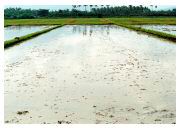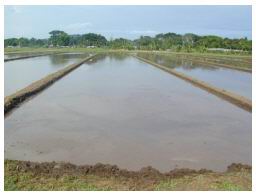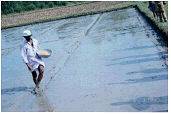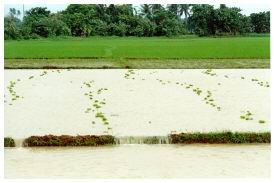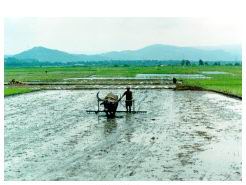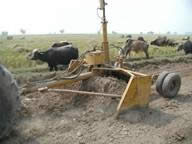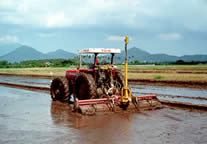|
|
|
Land preparation |
|
|
|
|
|
|
|
|
|
Land levelling |
|
|
|
|
|
|
|
|
|
Describe the benefits of levelled land |
|
Improves crop establishment
Reduces weed problems
Improves uniformity of crop maturity
Decreases time to complete tasks
Reduces water required for land preparation |
|
What are the benefits of land leveling?
Effective land leveling reduces the work in crop establishment and crop management, and increases the yield and quality.
1. Higher yield Good field leveling increases the rice yield considerably. In two experiments conducted at different localities, a strong correlation was found between the levelness of the land and crop yield. (see chart)
2. Better weed control Land leveling increases yield to a large extend because it improves weed control. Improved water coverage from better land leveling reduces weeds by up to 40%. This reduction in weeds results in less time for crop weeding. A reduction from 21 to 5 labor-days/ha is achieved. This represents a reduction of up to 16 person-days per hectare – a 75% decrease in the labor required for weeding.
Weeds under water (left) and complete eradication of weeds (right)
3. Larger farming area Good land leveling enables larger fields. Larger fields increase the farming area and improve operational efficiency. Increasing field sizes from 0.1 hectare to 0.5 hectare increases the farming area by between 5% and 7%. This increase in farming area gives the farmer the option to reshape the farming area and can reduce operating times by 10% to 15%.
4. Faster seeding/Less work Leveling reduces the time needed for transplanting and for direct seeding. Land leveling provides greater opportunity to use direct seeding. The possible reduction in labor by changing from transplanting to direct seeding is approximately 30 person-days per hectare.
Direct seeding on a level field
5. Better use of water Rice farmers using animal or 2-wheel tractors rely on water to accumulate in the field before starting land preparation. The higher the difference between the highest and lowest portions of a rice field, the more water is needed to achieve complete water coverage. Good leveling may reduce total water requirement to grow the crop by up to 10%.
Leveled terraces allow a proper water flow |
|
Different field conditions require different systems and operating time to complete the task. |
|
How can you get the land leveled?
A. By draft animals,such as buffalo and oxen, and 2-wheel tractors using harrows and leveling boards. These leveling techniques require total water coverage of the field and require 7 to 8 days for a 2-wheeled tractor and 12 days per hectare of land using draft animals.
Land levelling with draft animal (left) or hand tractor (right)
B. By a 4-wheel tractor using rear mounted tractor blades or drag buckets. 4-wheel tractors are very effective for leveling both wet and dry fields. Wet fields are best leveled with a rear-mounted tractor blade. Dry fields are best leveled using hydraulically operated drag buckets.
Major land leveling usually involves moving dry soil using “buckets”
Tractor work rates are dependent on the tractor’s capacity and the amount of soil to be moved. It takes approximately 8 hours to level 1 hectare with a rear mounted tractor blade. This reduces to about 4 hours when using a drag bucket.
C. By a 4-wheel tractor with a laser-controlled bucket. The use of laser controlled equipment results in a much more level field – up to 50% better than leveling using other techniques.
Leveling using a laser guided bucket on dry soil
or a laser guided blade on wet soil
Laser leveling systems are commonly used in agricultural applications in Australia, Japan and the United States. Increasingly, laser guided systems are being used in lesser developed country contexts as well. Using laser leveling results in a much more level field because accuracy can be improved by as much as 50% compared with the other systems.
The laser directs the tractor's bucket up and down
A laser transmitter transmits a laser beam, which is intercepted by the laser receiver mounted on the leveling bucket. The control panel mounted on the tractor interprets the signal from the receiver and raises or lowers the bucket. This way the soil gets shifted to the right places to make the entire field level.
|
|
|
|
|
What is the cost of land leveling? (Click the icon to see more info on the costs of land leveling) |
|
|
|
|
Aland and laser leveling training manual (Click on the icon) |
|
|
|
|
What are the benefits and limitations of laserleveling over other land leveling methods? (Click on the icon) |
|
Go online to see more info |
|
For more pictures and information on land levelling, please visit: http://www.knowledgebank.irri.org/landLeveling/WebHelp/default.htm
|
|
|
|
|
|
|
Next lesson |
|
In the next lesson we will discuss the types of farm power, and discuss each advantages. |
|



